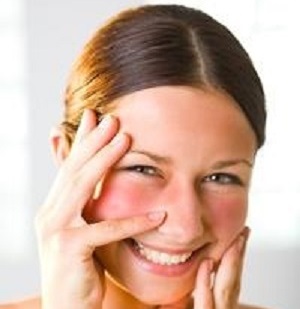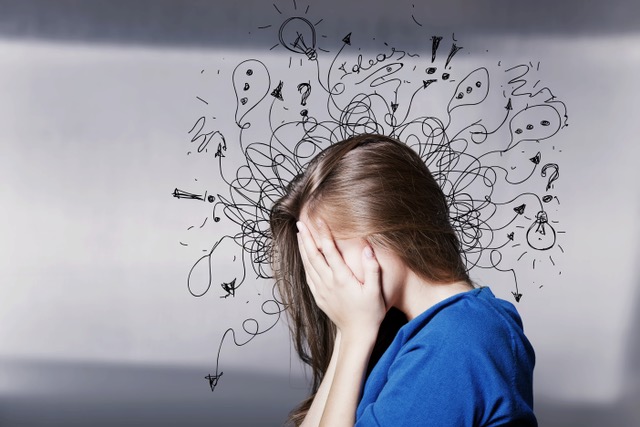For those struggling with social anxiety, there may be a myriad of different worries that lead to avoiding social or performance events. Worries such as “I won’t be able to come up with anything good to say” or “I’ll make a stupid mistake and embarrass myself” are very common. For some individuals, the worry that brings on the most fear is simply that someone else will notice they are anxious. Often this worry is linked to a specific physical symptom of anxiety that the person would not want others to see. Common physical symptoms that people fear may be noticed include: blushing, shaking, sweating or wavering voice.
The Anxiety Cycle
Noticing when our body is having a physical reaction is totally natural. When we are cold, our body tells us and we grab a blanket. When our nose feels stuffy, we notice and grab a tissue. However, looking for certain sensations and trying to prevent those sensations can create a unique cycle. As an example, try focusing on your throat for the next minute—does it feel normal or a bit tight? Try swallowing a few times. Does the swallowing feel easy or are you having any difficulty? Does your throat feel any different than usual?
While focusing on these sensations, you may have noticed your throat becoming tighter and your swallowing feeling more labored than it had a moment before. This is not a sign that something is wrong, but rather, evidence that when we give unnecessary thought and attention to our body, we may become anxious and our body may have a physical reaction. This reaction can be even more pronounced when we are not only looking for sensations, but desperately hoping they will not appear. In the case of social anxiety, if a person is prone to blushing when nervous and they really want to prevent such a reaction, they are likely to be hyperaware of that sensation in a social setting and ready to make an exit the moment it kicks in. While this effort to prevent others from seeing their anxious symptom may seem helpful to them, the fact that they are looking for that sensation and trying to stop it may actually backfire by creating more anxiety and increasing that physical blushing response.
The person’s thoughts about their blushing further intensify this cycle. For instance, if they tell themselves “Blushing is a sign of weakness—I will look like a fool if my face reddens in this meeting,” they are likely to feel more anxious and more aware of the sensation, leading to a greater chance of the symptom appearing. Behavior also plays a role in this cycle. If the person flees a situation as soon as their face starts to feel warm, they learn to continue avoiding the situation in the future, and they are likely to continue believing that it will be disastrous if the blushing happens in front of others, making the anxiety about blushing even stronger.
While the above example of the thought/anxiety/physical symptom/behavior cycle may seem tricky, understanding what maintains this pattern gives us clues as to how we can respond in a more helpful way. Let’s look at some strategies for breaking out of the cycle, using a person with a blush response as an example.
Addressing the Focus We Place on Physical Symptoms
As previously illustrated, placing extra attention on our sensations can often intensify the physical response. Although trying to force ourselves not to notice or think about something at all can often backfire (try NOT thinking about a pink elephant for the next 60 seconds and you’ll see what I mean!), we can practice having a more accepting response when we notice a sensation, and we can practice giving it less of our attention. This would involve non-judgmentally acknowledging that we notice the sensation and then bringing our focus back to the present. Here is an example: “Oh, my face is starting to feel warmer. That’s okay, let me just focus on what my friend is saying right now so that I don’t miss anything”. We can also practice not purposely looking for our sensations when in a triggering situation. Instead, we can tune into other aspects of our environment to stay more grounded in the present.
Addressing the Anxious Thinking
If thinking negatively about our symptoms increases our anxiety and physical response, we can practice more accepting and realistic thoughts to break that cycle. Anxious thinking about our sensations can be addressed using cognitive restructuring, a technique in which we ask questions to shift towards more helpful thoughts. Rather than automatically accepting our initial thought that “blushing is a sign of weakness and people will reject me if they see my face redden,” we can ask ourselves questions such as:
- How much do I really notice when others blush?
- Would I automatically judge someone as weak and reject them if I observed them blushing?
- Have I actually been rejected and told I am weak when I blush, or am I making an assumption about what will happen?
- Regardless of what others are thinking, is it helping me to be so judgmental of my blushing and to leave a situation when it starts to happen?
Using questions such as these, we might be able to come up with a more helpful set of thoughts about blushing, such as:
“I don’t know that anyone will actually notice—I don’t notice every subtle physical change in other people, and I’ve only had someone comment on my blushing once or twice in the past. Even if they do notice, I don’t know that they will assume it’s an anxiety symptom. People can look flush for other reasons, such as feeling warm or being excited. Especially if your skin is pale, blushing can be very common. If they do assume that I’m anxious or embarrassed, maybe that’s not the worst thing either. I wouldn’t reject someone or see them as weak if they admitted to being a little nervous. People get nervous all the time—it’s a pretty normal emotion. Blushing also doesn’t last very long. It clears up on it’s own.”
Addressing the Behavior
As previously mentioned, our behavior can play a big part in the anxiety cycle. Here are some interventions to approach our anxiety in a different way:

Exposure to feared situations: Rather than avoiding situations where physical symptoms may appear, we can practice confronting these situations. This serves two purposes: 1. allowing us to test out whether or not our feared outcome will actually occur as imagined and 2. allowing us to practice responding to the situation in a different way by sticking it out, rather than trying to make a quick exit. Exposure does not have to involve confronting your most feared situation immediately. It can be done on a hierarchy in which you begin with less challenging situations and advance to more triggering situations. Here are some examples:
- speaking up in front of a group of friends
- saying something silly or embarrassing to a store associate
- purposely making a mistake in front of a cashier
- asking a question in class or a work meeting
With each exposure, it will be helpful to pay attention to whether or not your fears came true (Did you blush? Did anyone comment on it? Was it a total catastrophe?) and to notice what was different about staying in the situation rather than leaving (Were you able to participate despite the sensation? Did the blushing fade on it’s own with time? Was there anything you would have missed out on if you had avoided the situation? What was positive about staying?). Even if some of your fears come true, it can be great practice for how to respond differently. For example, instead of freezing up and shutting down or leaving the room if someone mentions your blushing, maybe you can try laughing it off and saying something to acknowledge it, such as “Yeah, pale skin, right? My face gets pink about almost anything!” or “Oh, yeah I can feel it—I guess I’m a little nervous about presenting? How about you?”
Exposure to feared sensations: Once we have started to get more comfortable with exposure to situations, we can challenge ourselves further by purposely exaggerating the sensations to get more practice with accepting them and letting it go if others comment. Here are some examples to amp up sensations:
Blushing: Doing something active before an exposure or purposely saying something more embarrassing
Sweating: Doing something active, sitting somewhere hot or wearing something warm before an exposure
Body shaking or wavering voice: Purposely exaggerating the body or voice symptoms
The goal isn’t to enjoy having these sensations, but to come to a more accepting and confident perspective, such as “it’s not a big deal if I blush”, “I can handle that”, or “I won’t let blushing stop me from having this experience”.
Making a Change
Although the anxiety cycle may seem daunting to tackle, understanding the cycle is an important first step towards making a change. By addressing the thoughts, behaviors, and the attention to physical sensations that maintain that cycle, we can create new, more helpful patterns. While some of these changes can be practiced independently, many individuals with social anxiety find it useful to seek professional help with this process through individual or group therapy.
Written by:
Erica Russell, LPCC, LMFT
NSAC Silicon Valley
(Cognitive Behavior Therapy Center of Silicon Valley)
Share this blog post











